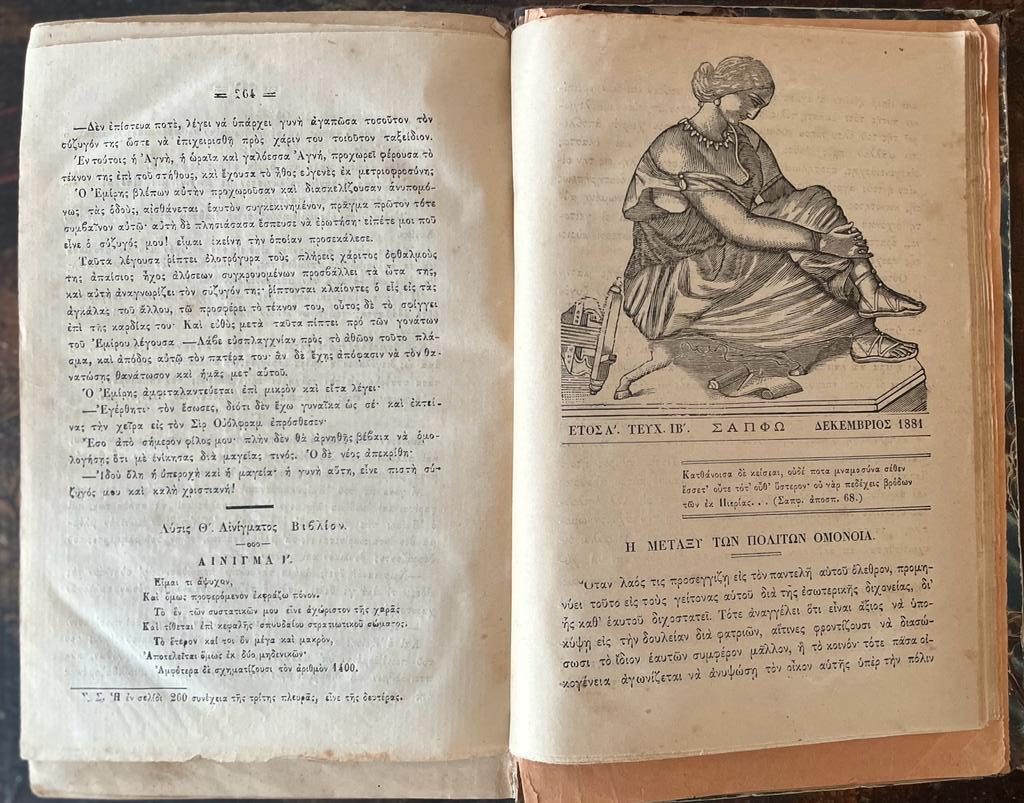Greek Magazine, Sappho, 1881, First Year, 12 Issues, Complete, Mytilini Printing, Archontopoulos
320.00€
Very rare Greek magazine printed in Mytilene Island in 1881
Description
ΣΑΠΦΩ
ἤτοι
Συλλογή ποικίλης, τερπνῆς καί ὠφελίμου ὕλης
Syllogi pikilis, terpnis kai ofelimou ylis
Tόμος πρῶτος
Περιέχων δώδεκα τεύχη
Μυτιλήνη, τυπογραφεῖο Ἡ Λέσβος, Γεωργίου Ἀρχοντοπούλου, 1881
Τά τεύχη 1-12 τοῦ Α´ ἔτους (Ἰανουάριος – Δεκέμβριος 1881) δεμένα σ’ ἕναν τόμο,
288 σ. (ὀξειδωμένα λίγα φύλλα)
Εἰκόνες ἐντός κειμένου (κάποιες ὁλοσέλιδες)
Δερμάτινη ράχη τῆς ἐποχῆς τῆς ἔκδοσης (φθορές)
Δρούλια & Κουτσοπανάγου, ΙV, σ. 63.
ΠΛΗΡΗΣ ΣΕΙΡΑ
SAPPHO
A Collection of Various, Pleasant and Useful Material
Volume I
Containing twelve issues
Mytilini, The Lesvos Printing House of Georgios Archontopoulos, 1881
First Edition, First Printing
Issues 1-12 of the 1st year (January – December 1881) bound in one volume
288 pp. (a few leaves are oxidized,)
Images within text (some full pages)
Leather spine of the time of publication (wear).
Droulia & Koutsopanagou, IV, p. 63
FULL SERIES
Sappho (Greek: Σαπφο, Σάπφω c. 630 – c. 570 BC) was an Archaic Greek poet from Eresos or Mytilini on the island of Lesbos.Sap pho is known for her lyric poetry, written to be sung while accompanied by music. In ancient times, Sappho was widely regarded as one of the greatest lyric poets and was given names such as the “Tenth Muse” and “The Poetess”. Most of Sappho’s poetry is now lost, and what is extant has mostly survived in fragmentary form, only the Ode to Aphrodite is certainly complete. As well as lyric poetry, ancient commentators claimed that Sappho wrote elegiac and iambic poetry. Three epigrams formerly attributed to Sappho are extant, but these are actually Hellenistic imitations of Sappho’s style.
Additional information
| Languages | Greek |
|---|









